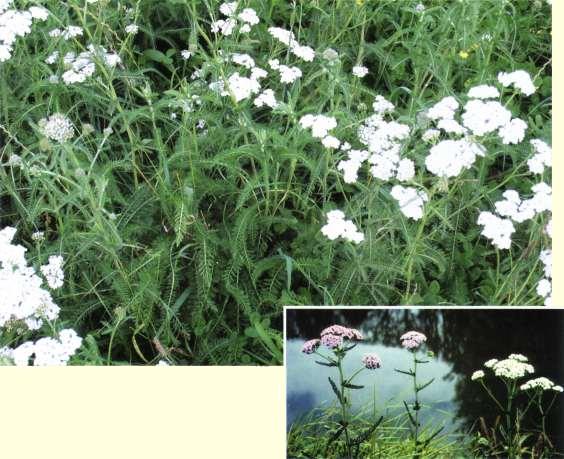|
 An
Illustrated Guide to An
Illustrated Guide to
Common Weeds
of New Zealand
Achillea
millefolium
yarrow
Family
ASTERACEAE
Reproduced from
Common
Weeds of New Zealand
by Ian Popay, Paul Champion & Trevor James
ISBN 0 473 09760 5
by kind permission of the
New
Zealand Plant Protection Society
Publication or other use of images or descriptive
text on these pages is unauthorised unless written permission is
obtained from the authors and publisher.
Appropriate acknowledgement
of the publication Common Weeds of New Zealand must always
be given.
Available from Nationwide Book Distributors
Erect or mat-forming,
rhizomatous, pleasant smelling perennial with feathery leaves, often
forming extensive patches on cultivated ground or in grassland.
White or occasionally pink flowers in heads in clusters at the top
of flower stalks, often about 50 cm high. Very common in pastures,
along road-sides and in waste places.
- Flowers
Individual flowers white, sometimes pink or reddish, 5-10 mm in
diameter, composite, with four to seven white, pink or red ray
florets and ten to twelve creamy disk florets. Flowers arranged
in dense, flat-topped, terminal compound corymbs up to about 15
cm across. Flowers Dec-May.
- Fruit
Greyish flattened achenes (seeds) 2 mm long, with narrow pale
brown wings and no pappus hairs.
- Leaves
Feathery, dark green, stalked, lance-shaped basal leaves up to
15 cm long by 2 cm wide, two- or three-times pinnate. Stem leaves
smaller and less divided.
- Stems
Erect or curved upwards at the tips, leafy, finely-furrowed, downy
further up.
- Roots
Fibrous, arising from nodes on the rhizomes.
Habitat
Arable land, pasture,
waste areas, road-sides, railways, industrial sites, lawns, marshy
and coastal places.
Distribution
Common throughout
NZ and the offshore islands, especially in drier areas. Originally
from Europe, Caucasia, Iran, Siberia and the Himalayas.
Comments
A very widespread
weed and component of pastures. It used to be sown as a drought-tolerant
pasture species and is readily grazed by stock. Since the time
of Achilles, yarrow has had a reputation for healing wounds. It
also has a number of other medicinal uses, including treatment
of fevers, muscular ailments and respiratory complaints.
Derivation
of botanical name
Achillea
(Gr.) = after the hero Achilles, said to have used it medicinally;
millefolium (Lat.) = thousand-leaved, a reference to
the finely divided leaves.
Web-notes:
Weed Links
On this site
Reproduced from Common Weeds
of New Zealand:
External Links
 Weedbusters
New Zealand Weedbusters
New Zealand
- Weedbusters is a weeds awareness and education programme that aims to
protect New Zealand's environment from the increasing weed problem.
- AgPest
- A free tool to assist farmers and agricultural professionals in decision-making regarding weed and pest identification, biology, impact and management.
 New Zealand Weeds Key New Zealand Weeds Key
- An interactive identification key to the weeds of New Zealand. Developed at Landcare Research.
New
Zealand Plant Conservation Network naturalised plants
- Search for information on more than 2500 naturalised and weedy plants.
 New
Zealand Plant Protection Society New
Zealand Plant Protection Society
- Their main objective: "To pool and exchange information on the biology
of weeds, invertebrate and vertebrate pests, pathogens and beneficial organisms
and methods for modifying their effects."
-
 Massey
University Weeds Database Massey
University Weeds Database- A site providing information about New Zealand weeds and weed control.
It has a series of pages showing pictures of New Zealand weeds, notes on
identification and control. It also provides information on a university
paper entitled Controlling Weeds.
-
-
More
Plant Profiles
|







